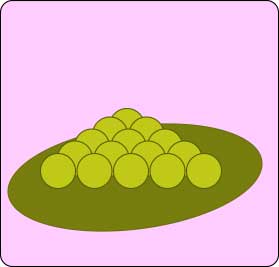Pyramid Scheme

In filling out the chart you might have noticed that it would be useful to
know how many balls are in each layer of the pyramid.
Of course, the number of the balls in the pyramid is the sum
of the number of balls in each layer.
But, the number of balls in layer N is Triangle(N),
the number of balls in a triangle with a base of N balls.
| N | 1 | 2 | 3 | 4 | 5 | 6 | 7 |
|---|---|---|---|---|---|---|---|
| Triangle(N) | 1 | 3 | 6 | 10 | 15 | 21 | 28 |
| Pyramid(N) | 1 | 4 | 10 | 20 | 35 | 56 | 84 |
Say that you know that there are Pyramid(N-1) balls in the first
N-1 layers (counting from the top of the pyramid).
Then the following scheme looks tempting:
Pyramid(N) = Pyramid(N-1) + Triangle(N)
